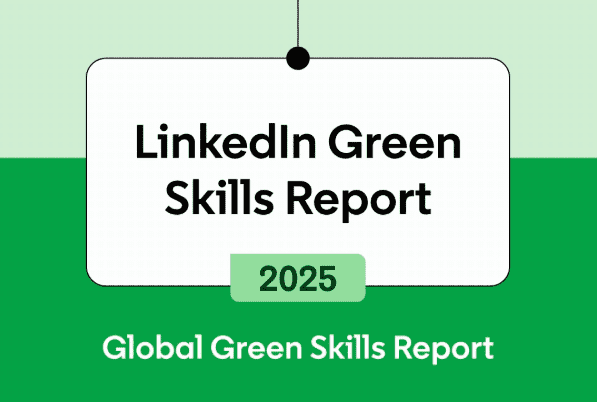Each year, LinkedIn’s Green Skills Report offers one of the clearest snapshots we have of the global green workforce: who’s getting hired, where the demand is growing, and how quickly our workforce is adapting to an economy shaped by climate action, electrification, and AI. The 2025 report shows a market in motion (not just expanding, but transforming) and many job seekers are missing the signal buried beneath the noise.
This year, the insights capture a decisive moment where ambition gives way to execution, where climate targets meet real-world constraints, and where the workforce begins to reorganize around a green-skills-driven economy. What’s more, these patterns strongly foreshadow how 2026 will unfold, especially for workers navigating a career transition into sustainability.
Below is a breakdown of what the 2025 report reveals, how it aligns with expert commentary across the climate-talent ecosystem, and what it really means for anyone looking to contribute to climate solutions in 2026.

1. Skills Are Outpacing Job Titles and That Changes Everything
One of the most striking findings: workers with green skills in non-green roles now make up 53% of all green hires.
This confirms a shift labor economists have long observed: job titles are the last thing to evolve during a structural market transition.
- Job content changes first.
- Tasks change second.
- Titles follow years later.
In 2025, this pattern fully took hold in climate work. The report notes that green skills have become foundational rather than niche, embedded into mainstream functions like operations, logistics, finance, manufacturing, and tech, not just sustainability departments.
What does this mean in practice?
- The sustainability job titles candidates search for (“Sustainability Manager,” “Climate Analyst,” etc.) represent only a slice of real hiring activity.
- The green job market is far larger than what appears on job boards.
- Many people are, in effect, looking in the wrong place.
2026 Outlook:
Expect job titles to remain lagging indicators. Companies will hire heavily for functions that embed sustainability (supply chain, energy management, product operations, risk, data centers) long before rewriting job titles to match. Job seekers who limit themselves to “green titles” will miss a huge portion of the market.
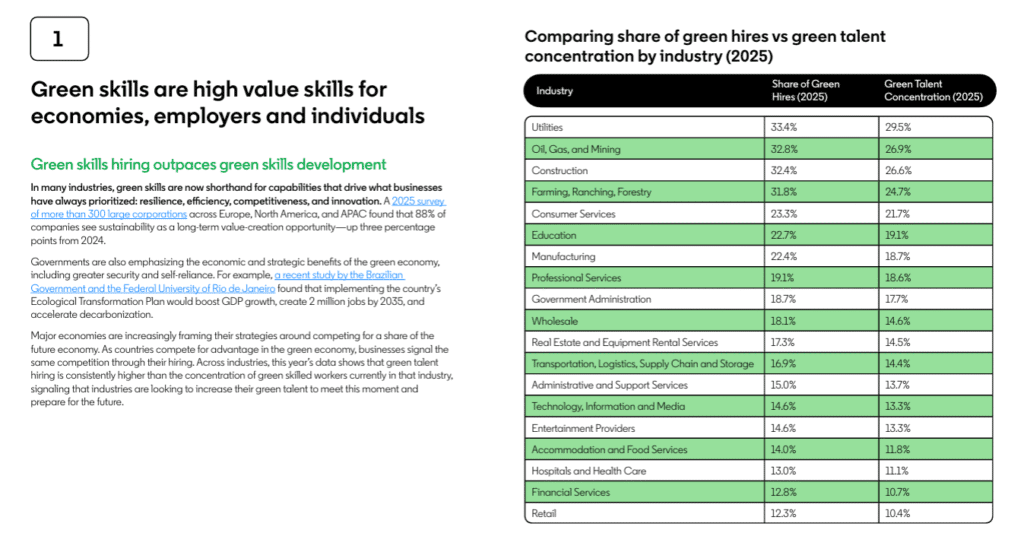
2. Hiring Managers Optimize for Capability, Not Credentials
While green skills development grew 4.3% this year, green hiring grew 7.7%, nearly twice as fast 2180-global-green-skills-report…. That gap is widening, and it signals something important:
Employers aren’t waiting for perfectly credentialed candidates.
They’re hiring for demonstrated capability.
According to the report, workers with green skills have a 46.6% higher hiring rate than the workforce overall 2180-global-green-skills-report….
That advantage persists even though:
- many workers lack formal sustainability education,
- titles may not reflect the underlying skills,
- career changers may not fit traditional molds.
The commentary you shared echoes this:
proof projects outperform job titles.
Hiring teams want to see whether you can solve the sustainability-aligned challenges they’re facing right now.
2026 Outlook:
The visibility gap will become more important than the skills gap.
Candidates who demonstrate capability through projects, portfolios, volunteer roles, audits, or assessments will leap ahead of those who stack certificates without showing applied skill.
3. Green Skills Are Becoming Core Business Skills Across Every Sector
This is the year green skills broke out of the “sustainability silo.”
Industries with the fastest growth in green skills from 2021–2025 include:
- Utilities
- Supply Chain & Logistics
- Technology, Information & Media
- Manufacturing 2180-global-green-skills-report…
These are sectors undergoing massive transformation—from electrification to AI resource management to climate-exposed supply chains.
Other highlights:
- Energy Management is the fastest-growing green skill globally (+17.4% YoY) 2180-global-green-skills-report….
- Retail, surprisingly, is accelerating its adoption of green skills—driven by consumer demand for greener brands.
- Government hiring for adaptation roles is rising, with green hiring in public administration hitting 18.7% in 2025 2180-global-green-skills-report….
- Climate resilience and adaptation are emerging as major green-jobs engines.
2026 Outlook:
Expect a continued rise in “blended” green roles—jobs in supply chain, energy, operations, real estate, and tech that quietly require sustainability fluency. By 2026, many traditional business roles will effectively become climate roles, even if they don’t carry the label.
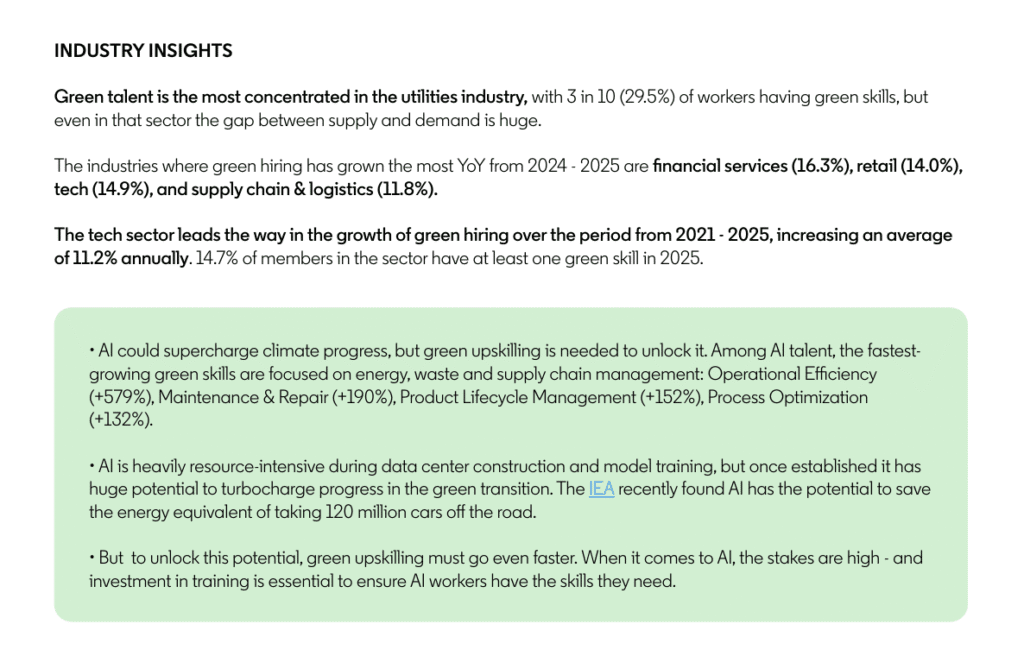
4. AI Is Accelerating, Not Replacing, the Need for Green Skills
The report dedicates a full chapter to the intersection of AI and green work, and it paints a clear picture:
- AI is driving huge increases in electricity and water demand.
- Green skills such as operational efficiency, maintenance & repair, circularity, and supply chain management are exploding among AI-adjacent talent.
- “Twin-transition skills”—the combined fluency in AI and sustainability—are becoming essential.
In 2025:
- 3.1% of green workers added AI engineering skills (a low baseline, but growing 38.6% YoY).
- AI talent rapidly added green skills like operational efficiency (+579%) and lifecycle management (+152%) 2180-global-green-skills-report….
This is one of the biggest “hidden” hiring trends.
2026 Outlook:
The climate-tech and AI-tech transitions will fuse into a single workforce trend, not two separate ones. Workers who combine AI literacy with sustainability competency will be among the most competitive candidates in the job market.
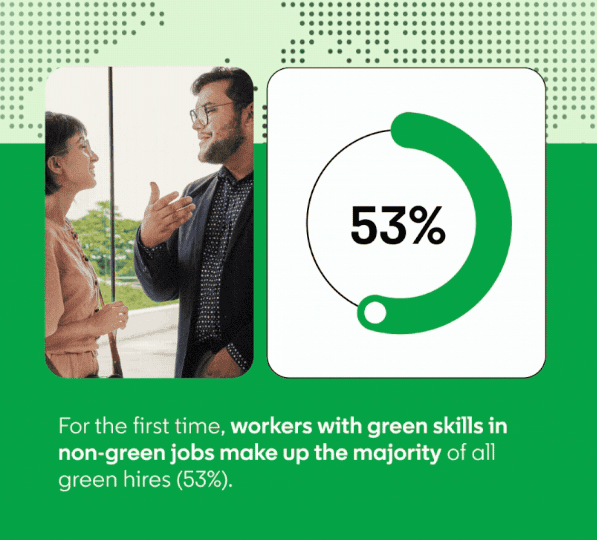

5. Gender Gaps Persist, But Skills-Based Hiring Can Help Close Them
Women are significantly less likely to hold green skills than men, especially in critical sectors like:
- Utilities
- Construction
- Logistics
- Technology 2180-global-green-skills-report…
Skills-based hiring could increase women’s representation in construction by 26% and in India’s utilities sector by 22%.
2026 Outlook:
Green workforce equity will move from a “nice to have” to a “must have.” Expect DEI and ESG to converge around green upskilling and accessibility.
6. The Real Problem Isn’t a Skills Gap, It’s a Visibility Gap
The report itself notes:
“Many individuals lack clarity on what green jobs or green skills are, how to build them, or how to break into the green economy.” 2180-global-green-skills-report…
Most people aren’t behind—they’re under-signaling.
In a world where titles lag and green skills hide inside non-green roles, candidates need a new way to help employers “see” their capability.
Proof Projects fill this gap:
- They translate past experience into climate-aligned contribution.
- They mirror the evidence hiring managers scan for.
- They bypass the credential-chasing trap.
In 2026, climate-aligned portfolios and demonstrated capability will matter more than ever.
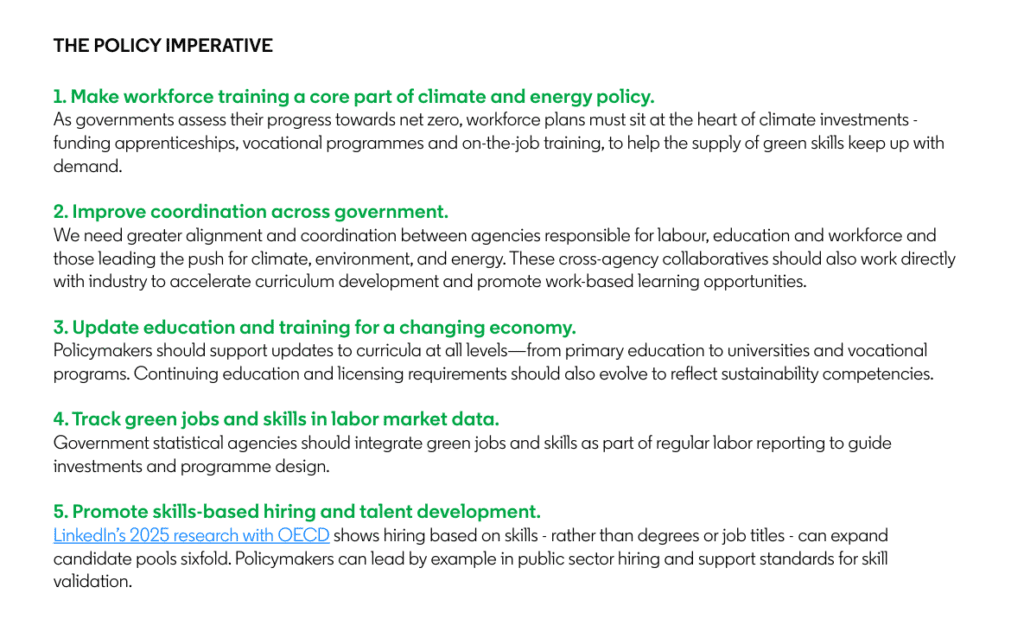
What This Means for 2026 Job Seekers
Here’s how to use these insights to reposition your career:
1. Stop searching by title—search by skills.
Look for roles with tasks involving:
- energy management
- operational efficiency
- supply chain resilience
- emissions reporting
- stakeholder engagement
- adaptation planning
2. Build and showcase proof—not just certificates.
Examples:
- complete a waste audit for a community organization
- design a sustainability engagement campaign
- build an adaptation plan for a hypothetical city department
- model emissions reductions from an operational change
3. Translate your existing experience into climate impact.
Many green skills are transferable, including:
- project management
- data analysis
- community engagement
- operations
- communications & storytelling
- design thinking
- customer education
4. Pair green skills with AI literacy.
Workers who understand both sustainability and AI resource implications will have a strategic edge.
5. Seek industries undergoing rapid transition.
The strongest 2026 opportunities will cluster in:
- Utilities & energy
- Tech (especially data centers and sustainable AI)
- Supply chain & logistics
- Manufacturing (EVs, materials, circularity)
- Government adaptation roles
The Bottom Line: 2025 Showed Us the Direction, 2026 Will Accelerate It
The 2025 LinkedIn Green Skills Report paints a picture of a workforce that is changing faster beneath the surface than most job seekers realize. Green skills are now business skills. Sustainability is becoming operational. And the fastest-growing green jobs are the ones without “green” in the title at all.
If 2025 was the year green skills became mainstream,
2026 will be the year they become non-negotiable.
The workers who succeed won’t simply be those who accumulate credentials—they’ll be the ones who communicate their capabilities clearly, visibly, and in alignment with the problems employers need solved right now.
And that’s good news. Because it means:
- You don’t need a sustainability degree.
- You don’t need to start over.
- You don’t need to wait for permission.
You just need to show what you can already do.

